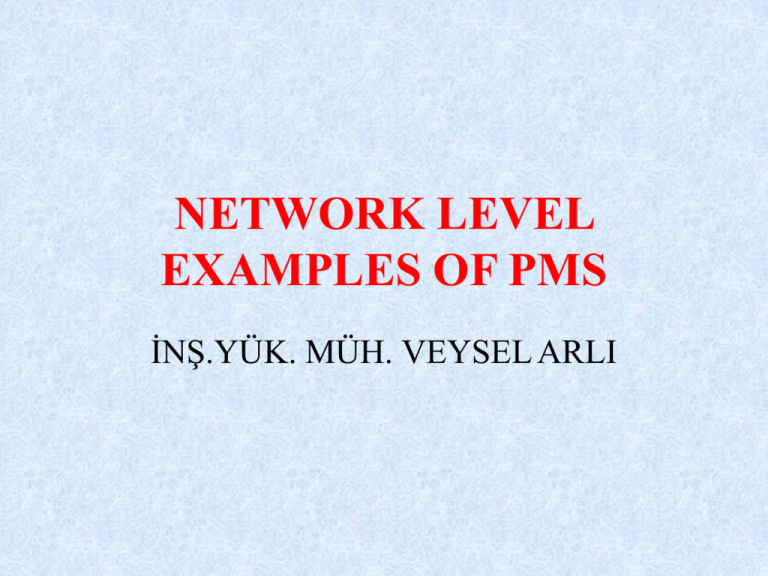NETWORK LEVEL EXAMPLES OF PMS
advertisement

NETWORK LEVEL EXAMPLES OF PMS İNŞ.YÜK. MÜH. VEYSEL ARLI MINNESOTA DOT NETWORK LEVEL PMS • MNDOT desired to develop and implement a pavement management system (PMS) specifically geared to the state’s requirements, resources, and conditions. • It operates on two primary data files, segment data and segment surface defect data. • The major outputs – Status and Needs Reports and Plots, – Optimization Reports and Plots Status Reports Needs Reports The trigger year occurs when the preticted performance for any particular index or parameter reaches a minimum acceptable level, as specified by the user. Rehabilitation Alternatives Analysis • There are three basic decision trees, one for concrete, one bituminous, and one for bituminous over concrete. • The decision tree is applied to each possible implementation year because the conditions used in the decision tree can change from year to year. • The present worth of costs is calculated for rehabilitation for each implementation year, ongoing maintenance, and user costs. • Also, cost-effectiveness for each alternativeimplementation year combination is calculated. Optimization Analysis • Optimization is based on marginal cost-effectiveness calculations. • The optimization analysis can be performed for these objectives: – effectiveness maximization, where the primary constraints are specified budget limits for each year of the program period – cost minimization, where the constraints are minimum average netwok performance or maximum percent of mileage below the minimum acceptable or trigger level. METROPOLITAN TRANSPORTATION COMMISSION PMS • The Metropolitan Transportation Commission (MTC) PMS is a simple and efficient system designed for network level pavement management. • It is a tool well suited to quickly and efficiently assess the condition of a road network, define and adjust maintenance treatments and costs, and examine the effects on road condition of specific maintenance budget allocation strategies. Description of the System • Necessary data from the pavement must be collected in terms of construction, traffic, date of last maintenance, etc., and entered in the PMS data base. • Then, the entire pavement network is divided ito uniform manageable sections for record and analysis purposes. • The Pavement Condition Index (PCI) is computed based on the observed distress types, severity, and extent. • A decision tree was developed which assigns the most cost-effective maintenance or rehabilitation strategy, depending on the PCI information, functional class, and cost information. • Seven major types of surface distress that occur predominatly in the Bay Area are considered by the condition assessment. These are: – – – – – – – alligator cracking distortion patching and utility cut patch rutting/depression longitudional and transverse cracking block cracking raveling and weathering •Distress is measured in square feet, except for longitudional and transverse cracking which are measured in linear feet. • Five pavement condition categories are defined based on a PCI scale with values ranging from 100 to 0 (excellent to failed) and depending on the load or non-load related distress. • The five category condition definition provides for a realistic maintenance and rehabilitation assignment. • A weighted effectiveness ratio is used to rank and prioritize projects. • The program selects projects identified for rehabilitation from highest-weighted effectiveness ratio to lowest until the funds allocated for rehabilitation are assigned. • The MTC PMS has been widely applied in California and has also been used by local agencies in other states.











